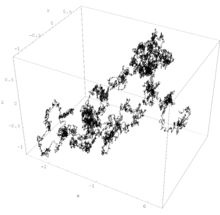Wiener sausage


In the mathematical field of probability, the Wiener sausage is a neighborhood of the trace of a Brownian motion up to a time t, given by taking all points within a fixed distance of Brownian motion. It can be visualized as a sausage of fixed radius whose centerline is Brownian motion. The Wiener sausage was named after Norbert Wiener by M. D. Donsker and S. R. Srinivasa Varadhan (1975) because of its relation to the Wiener process; the name is also a pun on Vienna sausage, as "Wiener" is German for "Viennese".
The Wiener sausage is one of the simplest non-Markovian functionals of Brownian motion. Its applications include stochastic phenomena including heat conduction. It was first described by Frank Spitzer (1964), and it was used by Mark Kac and Joaquin Mazdak Luttinger (1973, 1974) to explain results of a Bose–Einstein condensate, with proofs published by M. D. Donsker and S. R. Srinivasa Varadhan (1975).
Definitions
[edit]The Wiener sausage Wδ(t) of radius δ and length t is the set-valued random variable on Brownian paths b (in some Euclidean space) defined by
- is the set of points within a distance δ of some point b(x) of the path b with 0≤x≤t.
Volume of the Wiener sausage
[edit]There has been a lot of work on the behavior of the volume (Lebesgue measure) |Wδ(t)| of the Wiener sausage as it becomes thin (δ→0); by rescaling, this is essentially equivalent to studying the volume as the sausage becomes long (t→∞).
Spitzer (1964) showed that in 3 dimensions the expected value of the volume of the sausage is
In dimension d at least 3 the volume of the Wiener sausage is asymptotic to
as t tends to infinity. In dimensions 1 and 2 this formula gets replaced by and respectively. Whitman (1964), a student of Spitzer, proved similar results for generalizations of Wiener sausages with cross sections given by more general compact sets than balls.
References
[edit]- Donsker, M. D.; Varadhan, S. R. S. (1975), "Asymptotics for the Wiener sausage", Communications on Pure and Applied Mathematics, 28 (4): 525–565, doi:10.1002/cpa.3160280406
- Hollander, F. den (2001) [1994], "Wiener sausage", Encyclopedia of Mathematics, EMS Press
- Kac, M.; Luttinger, J. M. (1973), "Bose-Einstein condensation in the presence of impurities", J. Math. Phys., 14 (11): 1626–1628, Bibcode:1973JMP....14.1626K, doi:10.1063/1.1666234, MR 0342114
- Kac, M.; Luttinger, J. M. (1974), "Bose-Einstein condensation in the presence of impurities. II", J. Math. Phys., 15 (2): 183–186, Bibcode:1974JMP....15..183K, doi:10.1063/1.1666617, MR 0342115
- Simon, Barry (2005), Functional integration and quantum physics, Providence, RI: AMS Chelsea Publishing, ISBN 0-8218-3582-3, MR 2105995 Especially chapter 22.
- Spitzer, F. (1964), "Electrostatic capacity, heat flow and Brownian motion", Probability Theory and Related Fields, 3 (2): 110–121, doi:10.1007/BF00535970, S2CID 198179345
- Spitzer, Frank (1976), Principles of random walks, Graduate Texts in Mathematics, vol. 34, New York-Heidelberg: Springer-Verlag, p. 40, MR 0171290 (Reprint of 1964 edition)
- Sznitman, Alain-Sol (1998), Brownian motion, obstacles and random media, Springer Monographs in Mathematics, Berlin: Springer-Verlag, doi:10.1007/978-3-662-11281-6, ISBN 3-540-64554-3, MR 1717054 An advanced monograph covering the Wiener sausage.
- Whitman, Walter William (1964), Some Strong Laws for Random Walks and Brownian Motion, PhD Thesis, Cornell University





